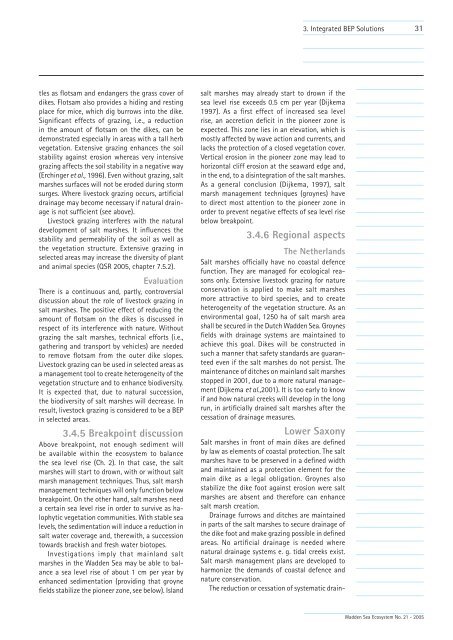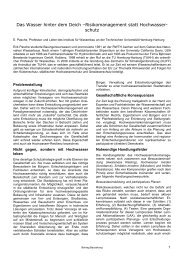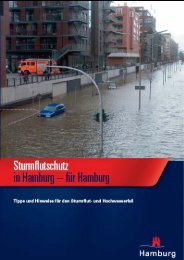Coastal Protection and Sea Level Rise - Hochwasser
Coastal Protection and Sea Level Rise - Hochwasser
Coastal Protection and Sea Level Rise - Hochwasser
Create successful ePaper yourself
Turn your PDF publications into a flip-book with our unique Google optimized e-Paper software.
3. Integrated BEP Solutions<br />
31<br />
tles as flotsam <strong>and</strong> endangers the grass cover of<br />
dikes. Flotsam also provides a hiding <strong>and</strong> resting<br />
place for mice, which dig burrows into the dike.<br />
Significant effects of grazing, i.e., a reduction<br />
in the amount of flotsam on the dikes, can be<br />
demonstrated especially in areas with a tall herb<br />
vegetation. Extensive grazing enhances the soil<br />
stability against erosion whereas very intensive<br />
grazing affects the soil stability in a negative way<br />
(Erchinger et al., 1996). Even without grazing, salt<br />
marshes surfaces will not be eroded during storm<br />
surges. Where livestock grazing occurs, artificial<br />
drainage may become necessary if natural drainage<br />
is not sufficient (see above).<br />
Livestock grazing interferes with the natural<br />
development of salt marshes. It influences the<br />
stability <strong>and</strong> permeability of the soil as well as<br />
the vegetation structure. Extensive grazing in<br />
selected areas may increase the diversity of plant<br />
<strong>and</strong> animal species (QSR 2005, chapter 7.5.2).<br />
Evaluation<br />
There is a continuous <strong>and</strong>, partly, controversial<br />
discussion about the role of livestock grazing in<br />
salt marshes. The positive effect of reducing the<br />
amount of flotsam on the dikes is discussed in<br />
respect of its interference with nature. Without<br />
grazing the salt marshes, technical efforts (i.e.,<br />
gathering <strong>and</strong> transport by vehicles) are needed<br />
to remove flotsam from the outer dike slopes.<br />
Livestock grazing can be used in selected areas as<br />
a management tool to create heterogeneity of the<br />
vegetation structure <strong>and</strong> to enhance biodiversity.<br />
It is expected that, due to natural succession,<br />
the biodiversity of salt marshes will decrease. In<br />
result, livestock grazing is considered to be a BEP<br />
in selected areas.<br />
3.4.5 Breakpoint discussion<br />
Above breakpoint, not enough sediment will<br />
be available within the ecosystem to balance<br />
the sea level rise (Ch. 2). In that case, the salt<br />
marshes will start to drown, with or without salt<br />
marsh management techniques. Thus, salt marsh<br />
management techniques will only function below<br />
breakpoint. On the other h<strong>and</strong>, salt marshes need<br />
a certain sea level rise in order to survive as halophytic<br />
vegetation communities. With stable sea<br />
levels, the sedimentation will induce a reduction in<br />
salt water coverage <strong>and</strong>, therewith, a succession<br />
towards brackish <strong>and</strong> fresh water biotopes.<br />
Investigations imply that mainl<strong>and</strong> salt<br />
marshes in the Wadden <strong>Sea</strong> may be able to balance<br />
a sea level rise of about 1 cm per year by<br />
enhanced sedimentation (providing that groyne<br />
fields stabilize the pioneer zone, see below). Isl<strong>and</strong><br />
salt marshes may already start to drown if the<br />
sea level rise exceeds 0.5 cm per year (Dijkema<br />
1997). As a first effect of increased sea level<br />
rise, an accretion deficit in the pioneer zone is<br />
expected. This zone lies in an elevation, which is<br />
mostly affected by wave action <strong>and</strong> currents, <strong>and</strong><br />
lacks the protection of a closed vegetation cover.<br />
Vertical erosion in the pioneer zone may lead to<br />
horizontal cliff erosion at the seaward edge <strong>and</strong>,<br />
in the end, to a disintegration of the salt marshes.<br />
As a general conclusion (Dijkema, 1997), salt<br />
marsh management techniques (groynes) have<br />
to direct most attention to the pioneer zone in<br />
order to prevent negative effects of sea level rise<br />
below breakpoint.<br />
3.4.6 Regional aspects<br />
The Netherl<strong>and</strong>s<br />
Salt marshes officially have no coastal defence<br />
function. They are managed for ecological reasons<br />
only. Extensive livestock grazing for nature<br />
conservation is applied to make salt marshes<br />
more attractive to bird species, <strong>and</strong> to create<br />
heterogeneity of the vegetation structure. As an<br />
environmental goal, 1250 ha of salt marsh area<br />
shall be secured in the Dutch Wadden <strong>Sea</strong>. Groynes<br />
fields with drainage systems are maintained to<br />
achieve this goal. Dikes will be constructed in<br />
such a manner that safety st<strong>and</strong>ards are guaranteed<br />
even if the salt marshes do not persist. The<br />
maintenance of ditches on mainl<strong>and</strong> salt marshes<br />
stopped in 2001, due to a more natural management<br />
(Dijkema et al.,2001). It is too early to know<br />
if <strong>and</strong> how natural creeks will develop in the long<br />
run, in artificially drained salt marshes after the<br />
cessation of drainage measures.<br />
Lower Saxony<br />
Salt marshes in front of main dikes are defined<br />
by law as elements of coastal protection. The salt<br />
marshes have to be preserved in a defined width<br />
<strong>and</strong> maintained as a protection element for the<br />
main dike as a legal obligation. Groynes also<br />
stabilize the dike foot against erosion were salt<br />
marshes are absent <strong>and</strong> therefore can enhance<br />
salt marsh creation.<br />
Drainage furrows <strong>and</strong> ditches are maintained<br />
in parts of the salt marshes to secure drainage of<br />
the dike foot <strong>and</strong> make grazing possible in defined<br />
areas. No artifi cial drainage is needed where<br />
natural drainage systems e. g. tidal creeks exist.<br />
Salt marsh management plans are developed to<br />
harmonize the dem<strong>and</strong>s of coastal defence <strong>and</strong><br />
nature conservation.<br />
The reduction or cessation of systematic drain-<br />
Wadden <strong>Sea</strong> Ecosystem No. 21 - 2005




